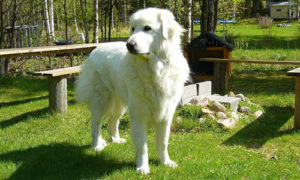
The Akita is a product of Japan and a versatile guardian and hunting dog. Early references to the breed date from the seventeenth century on the island of Honshu. At one time, only Japan’s imperial family and the ruling aristocracy could own Akitas.

This is one of seven Japanese breeds designated as a Natural Monument in its native land. The dog came to America’s attention in 1937 when Helen Keller received a puppy as a gift while visiting Japan. Later on, the breed’s popularity increased in the United States following World War II. Thanks to the dogs’ returning home with U.S. troops
This dog is a dominant, imposing, working dog with dense bone; slightly rectangular proportions; a broad, deep chest; and a level back. Additionally, the long, bushy tail is set high and curled over the back. The head is full and triangular. Also, the Akita’s small eyes and the erect ears create a keen, alert expression.
Akita Breed Facts
- POPULARITY: Popular
- FAMILY: Northern
- AREA OF ORIGIN: Japan
- DATE OF ORIGIN: Unknown
- ORIGINAL FUNCTION: Large game hunting, dog fighting, guardian
- TODAY’S FUNCTION: Security, companion
- OTHER NAME: Akita Inu, Japanese Akita
Activity level: These dogs need daily exercise. However, use caution in hot weather. Exercise them on a leash or in a secured area, as their hunting instincts cause them to roam.
Temperament

This dog possesses the courage, perseverance, and endurance to hunt large, dangerous quarry such as boar and bear. Also, the breed is equally skilled at hunting small prey and retrieving waterfowl. At one time, the Japanese people used them to drive fish into nets.
This breed is typically loyal and devoted to their families. However, they’re reserved and dignified with strangers. They are strong-willed and protective, with good guardian instincts.
Puppy socialization is essential to ensure that they are tolerant of strangers. The temperament varies from calm to dominant. Therefore, take care when introducing them to children and other pets.
Grooming
These dogs are famous for their meticulous habits and will groom themselves like cats. However, they will need brushing daily during heavy shedding in spring and fall; brush weekly at other times.
Coat: Double coat with a harsh exterior coat and a thick undercoat
Color: All colors, including brindle and pinto (white with colored patches on the head and body)
Health Issues

- Major concerns: CHD, PRA
- Minor concerns: elbow dysplasia, pemphigus, sebaceous adenitis, gastric torsion, cruciate ligament rupture, osteosarcoma, lymphosarcoma, hypothyroidism
- Occasionally seen: PRA, patellar luxation, VKH-like syndrome, entropion, epilepsy, cataract, polyneuropathy, renal cortical hypoplasia, microphthalmia
- Suggested tests: hip, (elbow), eye, thyroid
- Life span: 10-12 years
- Note: Akitas are especially sensitive to anemia from red blood cells damage caused by eating onions
- Weight: male: 85-115 pounds; female: 65-90 pounds
- Height: male: 25-28 inches; female: 23-26 inches
Akita Buyer’s Guide and Advice
Owning this dog is a big responsibility. Therefore, do not take ownership lightly. Be prepared to invest time and effort into training and socializing your dog.
Parent club: Akita Club of America; founded in 1956
Regional clubs: Click on “Regional Akita Clubs” under “Members” on the club’s website
Rescue: The Akita Club of America lists rescue information on its website under “Akita Rescue.”





